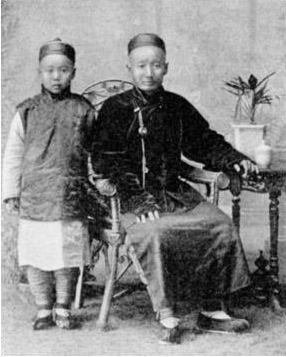History of the Jews in China
Exact_or_scaled-down_duplicate:_thumb|left
==History of the Jews in China ==
The history of the Jews in China dates back to at least the Tang dynasty (618–907 CE), with some scholars suggesting earlier dates. The Jewish community in China has experienced various periods of growth and decline, influenced by both internal Chinese dynamics and external global events.
Early History[edit | edit source]
The earliest evidence of Jews in China comes from the Tang dynasty, where Jewish merchants traveled along the Silk Road and settled in cities such as Xi'an. These merchants were part of the broader network of Silk Road trade that connected China with the Middle East and Europe.
Kaifeng Jews[edit | edit source]
One of the most well-documented Jewish communities in China is the Kaifeng Jews. The community in Kaifeng, the capital of the Song dynasty (960–1279 CE), is believed to have been established by Jewish merchants from Persia or India. The Kaifeng Jews built a synagogue in 1163, which became a central place of worship and community life.
The Kaifeng community maintained Jewish traditions, including observing the Sabbath, kosher dietary laws, and celebrating Jewish holidays. However, over time, the community assimilated into Chinese society, adopting Chinese customs and language.
Ming and Qing Dynasties[edit | edit source]
During the Ming dynasty (1368–1644) and the Qing dynasty (1644–1912), the Jewish community in Kaifeng continued to exist but faced challenges such as natural disasters and social changes. The community's synagogue was destroyed by floods in the 17th century and was rebuilt several times.
By the late Qing dynasty, the Kaifeng Jews had largely assimilated, and many Jewish practices had faded. However, some families continued to identify as Jewish and preserved certain traditions.
20th Century[edit | edit source]
In the early 20th century, new Jewish communities emerged in China, primarily composed of Ashkenazi Jews fleeing persecution in Russia and Eastern Europe. Cities such as Shanghai and Harbin became significant centers of Jewish life.
During World War II, Shanghai became a refuge for thousands of European Jews escaping the Holocaust. The Shanghai Ghetto was established by the Japanese authorities, where Jewish refugees lived alongside the local Chinese population.
Contemporary Period[edit | edit source]
Today, the Jewish community in China is small but diverse, consisting of descendants of the Kaifeng Jews, expatriates, and business professionals. There are active Jewish organizations and synagogues in major cities such as Beijing, Shanghai, and Hong Kong.
Cultural and Historical Impact[edit | edit source]
The history of the Jews in China reflects a unique blend of Jewish and Chinese cultures. The Kaifeng Jews are a testament to the long-standing presence of Jews in China and their ability to adapt and integrate into Chinese society while maintaining their identity.
See Also[edit | edit source]
- Kaifeng Jews
- Shanghai Ghetto
- Silk Road
- Tang dynasty
- Song dynasty
- Ming dynasty
- Qing dynasty
- Ashkenazi Jews
Categories[edit | edit source]
This Jewish history related article is a stub. You can help WikiMD by expanding it.
Search WikiMD
Ad.Tired of being Overweight? Try W8MD's physician weight loss program.
Semaglutide (Ozempic / Wegovy and Tirzepatide (Mounjaro / Zepbound) available.
Advertise on WikiMD
|
WikiMD's Wellness Encyclopedia |
| Let Food Be Thy Medicine Medicine Thy Food - Hippocrates |
Translate this page: - East Asian
中文,
日本,
한국어,
South Asian
हिन्दी,
தமிழ்,
తెలుగు,
Urdu,
ಕನ್ನಡ,
Southeast Asian
Indonesian,
Vietnamese,
Thai,
မြန်မာဘာသာ,
বাংলা
European
español,
Deutsch,
français,
Greek,
português do Brasil,
polski,
română,
русский,
Nederlands,
norsk,
svenska,
suomi,
Italian
Middle Eastern & African
عربى,
Turkish,
Persian,
Hebrew,
Afrikaans,
isiZulu,
Kiswahili,
Other
Bulgarian,
Hungarian,
Czech,
Swedish,
മലയാളം,
मराठी,
ਪੰਜਾਬੀ,
ગુજરાતી,
Portuguese,
Ukrainian
Medical Disclaimer: WikiMD is not a substitute for professional medical advice. The information on WikiMD is provided as an information resource only, may be incorrect, outdated or misleading, and is not to be used or relied on for any diagnostic or treatment purposes. Please consult your health care provider before making any healthcare decisions or for guidance about a specific medical condition. WikiMD expressly disclaims responsibility, and shall have no liability, for any damages, loss, injury, or liability whatsoever suffered as a result of your reliance on the information contained in this site. By visiting this site you agree to the foregoing terms and conditions, which may from time to time be changed or supplemented by WikiMD. If you do not agree to the foregoing terms and conditions, you should not enter or use this site. See full disclaimer.
Credits:Most images are courtesy of Wikimedia commons, and templates, categories Wikipedia, licensed under CC BY SA or similar.
Contributors: Prab R. Tumpati, MD



